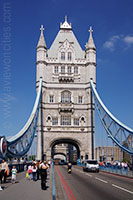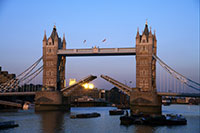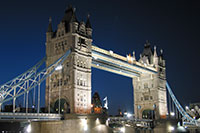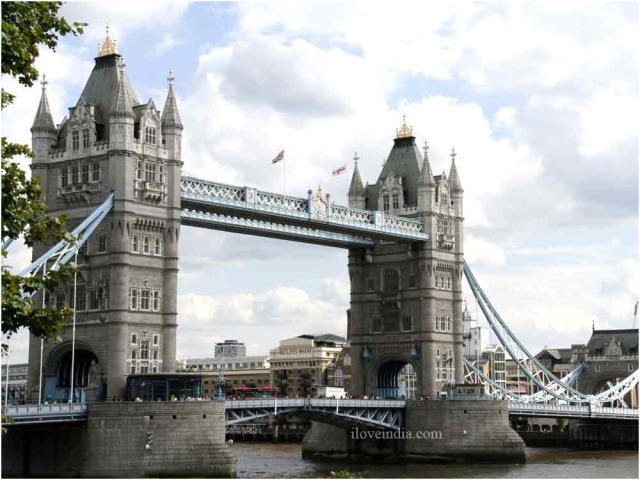Internet Debris

A collection by Neal McKenna
McKenna Ink Thesis Editing Service
To add your comments,
click here.
NOTHING posted here is mine!
Internet Debris does not claim rights
to any of the photos or media content posted to the site.
No copyright infringement is intended.
A collection by Neal McKenna
McKenna Ink Thesis Editing Service
To add your comments,
click here.
NOTHING posted here is mine!
Internet Debris does not claim rights
to any of the photos or media content posted to the site.
No copyright infringement is intended.
London's Tower Bridge
London's Tower Bridge is one of the most recognisable bridges in the world. Its Victorian Gothic style stems from a law that forced the designers to create a structure that would be in harmony with the nearby Tower of London.

Tower Bridge
Plans for the Tower Bridge were devised around 1876 when the east of London became extremely crowded and a bridge across the Thames in that area of the city seemed a necessity. It would take another eight years - and lots of discussions about the design - before construction of the bridge started.
The bridge, designed by city architect Horace Jones in collaboration with John Wolfe Barry, would eventually be completed in 1894. Five contractors and nearly 450 workers were involved in the construction of the 265 meter long bridge. It took 11,000 tons of steel to build the framework. At the time many people disliked its Victorian Gothic design, but over time the bridge became one of London's most famous symbols.
Mechanics

Tower bridge raising
The proximity of the harbor and its location in the direction of the sea required for the bridge to allow the passage of large vessels. Hence the decision to create a moveable bridge which can be opened to accommodate boat traffic. The mechanism to open the bridge is hidden in the two towers. Until 1976, when the mechanism became electrified, steam power was used to pump water into hydraulic accumulators which powered the engines.
Each deck is more than 30 meters wide and can be opened to an angle of 83 degrees. When opened the bridge has a clearance of almost 45 meter. It used to open almost 50 times a day but nowadays it is only raised about 1,000 times a year.

Bridge lifts are pre-scheduled (for cruise ships, etc) so visitors can check the bridge's website to find out when it will rise and lower.
Visiting the BridgeEach deck is more than 30 meters wide and can be opened to an angle of 83 degrees. When opened the bridge has a clearance of almost 45 meter. It used to open almost 50 times a day but nowadays it is only raised about 1,000 times a year.

Tower Bridge at night
Taking photographs of the Tower bridge is a favorite London tourist activity, but you can also go inside the bridge, where you'll have a magnificent view over London from the walkway between the two bridge towers.
Inside the bridge is the Tower bridge Exhibition, a display area that encompasses the walkway and the two famous towers where you can observe the Victorian engine room. Visitors can learn about the history of the bridge via photos, films, and other media. Text and images via A View on Cities
Tower Bridge Under Construction
Stripped down as you've never seen her:
Pictures of Tower Bridge during construction found dumped in a skip
Stripped down to her underwear, the never before seen pictures of Tower Bridge - one of the world's most recognisable structures - have been unveiled after the stash of hundred-year-old prints were found in a skip.
Coinciding with the 125th anniversary of the bridge's foundation, the 50 sepia photos reveal in incredible detail the ingenuity behind one of the capital's most popular tourist destinations, which was the first bridge of its kind in the world.

This is one of the London's most beloved landmarks as you've never seen her before.
The pictures of London's Tower Bridge were found in a skip and then wrapped up in brown paper and put in a carrier bag under a bed
These unique pictures, dating back to 1892, document the construction the iconic bridge, which at the time was a landmark feat of engineering nicknamed "The Wonder Bridge."
The discarded pictures, which were retrieved by a caretaker who was looking after a building being turned into flats in 2006, have spent the last five years in a carrier bag underneath his bed.
The 59-year-old, who wishes to remain anonymous, said that after the occupants of the Westminster office building moved out, the album and a number of documents were thrown into a skip outside.
He said: "I took the ledgers to the Tower Bridge Museum because I thought they might have some historical value.

Remarkable find: The prints reveal in incredible detail the ingenuity behind one
of the capital's most popular tourist attractions and how it was put together.

A view of the bridge: The sturdy steel frame of Tower Bridge can be seen, before it was covered with its distinctive stone-cladding on the orders of architect John Wolfe-Barry.
"They included records of the materials and used in the bridge's construction and what they cost.
"I told the man at the museum that I had also found some photos but he told me they already had plenty of those.
"I didn't know what to do with them so I wrapped them in some brown paper and put them in a bag under the bed." It wasn't until earlier this month, when the owner of the photos mentioned them to his neighbour, City of Westminster tour guide Peter Berthoud that the significance of the find fully emerged.
Mr Berthoud, an expert in the history of London who gives guided tours around famous landmarks including Tower Bridge , said he was gobsmacked by the haul.

Stripped down: The photographs show how the bridge was put together over eight years, revealing why it was nicknamed at the time the ' Wonder Bridge.'
Landmark: Tower Bridge remains one of the capital's most iconic structures and a tourist attraction today, 125 years after building started.
Sepia to silver screen: The incomplete Tower Bridge features in the 2009 film Sherlock Holmes, where Holmes battles with his adversary Lord Henry Blackwood.
And contrary to popular misconception, the images reveal the bridge is a sturdy steel frame beneath the instantly recognisable stone-cladding.
Mr Berthoud said: "When my neighbour gave me a disk with the images on I just couldn't believe it.
"I spent hours going through my books to see if these pictures were already around, but I couldn't see them anywhere - they are totally unique.
"Quite simply London Bridge is the world's most iconic bridge, and it's the only bridge over the Thames which has never needed to be replaced at some point.
Discovery: Peter Berthoud was gobsmacked when his neighbour showed him
the haul of photos. He spent hours going through books to find something similar,
only to discover they are totally unique.
Transformation: The bridge took eight years to build and at the time
was a landmark feat of engineering, combining elements of a suspension
and high level bridge and a bascule
"It combines elements of a suspension bridge, a high level bridge and a bascule which allows it to open for ships to pass.
"Nothing had ever been made like it before, and nothing since.
"People are always surprised when I tell them Tower Bridge is a steel bridge, as the stone cladding is so recognisable."
According to the tour guide, the bridge's original architect, Horace Jones, wanted to clad the bridge in brick, however, following his death he was succeeded as architect by John Wolfe-Barry who decreed the bridge should be clad in stone.
Development: Photos show the progress in the construction process, from basic structures to something easily recognisable as Tower Bridge as we know it today
Unique: Many of the 50 sepia prints are in good condition, despite dating back to 1892. Several are even dated, making it possible to trace the progress in construction
Although many of the century-old pictures are in a state of disrepair, around 20 are in good condition.
Many of the 12 by 10 snaps are dated and clearly show how the bridge was put together over a space of eight years.
Memorable scenes include turn-of-the-century labourers taking orders from a site foreman in a bowler hat, and a shot of the bridge's original steam-powered engine room, which could open the bridge in less than a minute.
In one poignant picture flags decorate the body of the bridge and a hand-written pencil note reads: "Note, flags denote Mr Hunter's wedding day."
Mr Berthoud said: "My favourite pictures of the simple, humble guys building the bridge, unaware that what they are making will be so historic.
"People are so used to seeing images of the Empire State Building being built, but this is part of British history created 50 years earlier."
Text and images via The Daily Mail
Tower Bridge Facts
The walkways of Tower Bridge provide mesmerizing views of St Paul's Cathedral, Canary Wharf, Maritime Greenwich and The London Eye.
Tower Bridge remains open on a daily basis. The timings are 10:00 to 18:30, from 1st April to 30th September, and 09:30 to 18:00, from 1st October to 31stMarch. It remains closed on 24th, 25th and 26th December.
Tower Bridge was designed by Horace Jones, the City Architect, in collaboration with John Wolfe Barry.
It took eight years, five major contractors and labor of 432 construction workers to complete the Tower Bridge.
The construction work on Tower Bridge was completed in 1894.
11,000 tons of steel was used to construct the framework for Towers and Walkways.
Cornish granite and Portland stone cover the steel structure of Tower Bridge.
The bascules of Tower Bridge were initially powered by energy created from steam. However, since 1976, oil and electricity are being used to produce the energy.
The original pumping engines, accumulators and boilers of Tower Bridge now form a part of the Tower Bridge Exhibition
The high-level walkways of Tower Bridge, to be used by pedestrians when bascules were up, were permanently closed in 1910, due to lack of use.
Tower Bridge was painted red, white and blue in 1977, as a part of the Queen's Silver Jubilee celebrations.
In 1982 Tower Bridge was opened to the public for the first time since 1910, with a permanent exhibition called the Tower Bridge Exhibition.
Tower Bridge became available on hire for parties and receptions since the year 1994.
The current Tower Bridge Exhibition was opened in 2002, with emphasis on Walkways views and history of the Bridge.
In 2007, Tower Bridge celebrated 25 years of welcoming visitors to its Exhibition.
The total length of Tower Bridge is 244 m (800 ft), while its longest span is 61 m (200 ft).
Tower Bridge connects Iron Gate (now Tower Bridge Approach), on the north bank of the river, with Horsleydown Lane (now Tower Bridge Road), on the south.
In May 1997, the 'unexpected' opening of Tower Bridge divided the motorcade of US President Bill Clinton.
Text and image via I Love India.com

Most bridges in the world are not ideal locations for throwing parties, but guests at a Tower Bridge event do not have to worry about dodging traffic. Within the bridge's towers and the walkways above are several event spaces with spectacular views that make Tower Bridge one of London's most popular venues
Text via USA Today
Spoooky Reading

What lies beneath...

The small nose on the inside of Admiralty Arch is a monument to the Duke of Wellington.
Legend has it that the Household Cavalry touch this strange protrusion every time they pass through the arch, as a mark of respect to the Iron Duke. In fact, it's one of several prosthetic noses placed around London by artist Rick Buckley and only dates back a decade or so.
There's a gas lamp on Carting Lane, off the Strand, powered by sewerage gas from the Savoy.
There is indeed a curious lamp at the lower end of Carting Lane. However, it is not quite correct to say that it is powered by sewer gas. The Webb Patent Sewer Gas Lamp, of which this is the only example left in London, was chiefly fueled by the mains supply of gas. However, a flue from the sewers did draw up waste gases for combustion along with the mains gas. The existing lamp on 'Farting Lane' is a replica.
The tower commonly known as Big Ben is actually called St Stephen's Tower
We've dealt with this one ad nauseum. In short, it's not. It's called the Clock Tower. But we reckon Big Ben should be acceptable as it's common parlance and less confusing. More here.
The Union Flag flying from Buckingham Palace means the Queen is at home.
Actually, it means the opposite. You're looking for the Royal Standard if you want confirmation of the Queen's residancy. The Union Flag above the Palace means she's elsewhere, doing other Queenish things.
Old London Bridge was sold to a gullible American who thought he was buying Tower Bridge
This factlet remains popular as it plays into stereotypes of wide-eyed Yanks with no sense of history. But there are several problems with the idea. It's true that the predecessor to the current London Bridge was bought by US businessman Robert P McCulloch and transplanted to Lake Havasu City in Arizona, where it can still be seen today. However, it wasn't "Old" London Bridge, a term usually reserved for the medieval span, which was demolished in the 1830s to make way for the John Rennie structure eventually purchased by McCulloch. There's also no evidence that he mistook his acquisition for Tower Bridge, a rumour that the American always denied (although most people would, to be fair).
There are 109 journeys between London's Tube stations that are quicker to walk.
This urban myth is only hours old, but looks set to gain currency. The figure is based on a blog post by Diamond Geezer from three years ago. Yesterday, however, researchers from the TV show QI tweeted the 'fact'to their 131,000 followers. Diamond Geezer has followed up with a new post explaining how the original number is blanketed in caveats and certainly not definitive. It'll be interesting to see if this one grows.
 The entrance to the Savoy is the only place in the UK where vehicles must drive on the right. Images and text via The Londonist
The entrance to the Savoy is the only place in the UK where vehicles must drive on the right. Images and text via The Londonist
Legend has it that the Household Cavalry touch this strange protrusion every time they pass through the arch, as a mark of respect to the Iron Duke. In fact, it's one of several prosthetic noses placed around London by artist Rick Buckley and only dates back a decade or so.
There's a gas lamp on Carting Lane, off the Strand, powered by sewerage gas from the Savoy.
There is indeed a curious lamp at the lower end of Carting Lane. However, it is not quite correct to say that it is powered by sewer gas. The Webb Patent Sewer Gas Lamp, of which this is the only example left in London, was chiefly fueled by the mains supply of gas. However, a flue from the sewers did draw up waste gases for combustion along with the mains gas. The existing lamp on 'Farting Lane' is a replica.
The tower commonly known as Big Ben is actually called St Stephen's Tower
We've dealt with this one ad nauseum. In short, it's not. It's called the Clock Tower. But we reckon Big Ben should be acceptable as it's common parlance and less confusing. More here.
The Union Flag flying from Buckingham Palace means the Queen is at home.
Actually, it means the opposite. You're looking for the Royal Standard if you want confirmation of the Queen's residancy. The Union Flag above the Palace means she's elsewhere, doing other Queenish things.
Old London Bridge was sold to a gullible American who thought he was buying Tower Bridge
This factlet remains popular as it plays into stereotypes of wide-eyed Yanks with no sense of history. But there are several problems with the idea. It's true that the predecessor to the current London Bridge was bought by US businessman Robert P McCulloch and transplanted to Lake Havasu City in Arizona, where it can still be seen today. However, it wasn't "Old" London Bridge, a term usually reserved for the medieval span, which was demolished in the 1830s to make way for the John Rennie structure eventually purchased by McCulloch. There's also no evidence that he mistook his acquisition for Tower Bridge, a rumour that the American always denied (although most people would, to be fair).
There are 109 journeys between London's Tube stations that are quicker to walk.
This urban myth is only hours old, but looks set to gain currency. The figure is based on a blog post by Diamond Geezer from three years ago. Yesterday, however, researchers from the TV show QI tweeted the 'fact'to their 131,000 followers. Diamond Geezer has followed up with a new post explaining how the original number is blanketed in caveats and certainly not definitive. It'll be interesting to see if this one grows.

To add your comments,
click on
links to this post
here or below. It will take you to a stand-alone copy of this page. There, you will find the comments box, so feel free to let 'er rip.
If you like what you see here
- tell your friends!











No comments:
Post a Comment